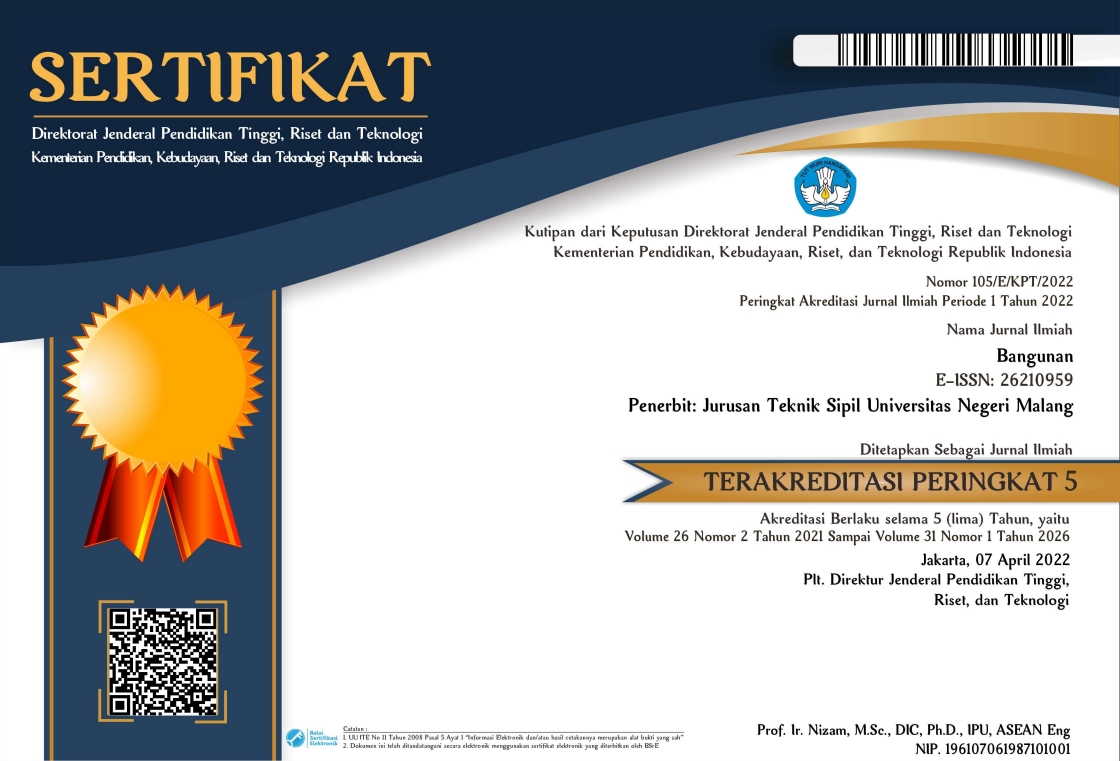ANALISIS DAKTILITAS BALOK BETON GRADASI DENGAN DISPARITAS MUTU BETON SERAT TEKAN DAN SERAT TARIK
Abstract
Abstrak: Industri semen menyumbang hingga 8% dari seluruh emisi gas karbon dioksida secara global. Beton gradasi merupakan salah satu langkah untuk mereduksi penggunaan semen pada konstruksi sekaligus untuk mengoptimalkan karakteristik mekanik elemen struktur yang direncanakan. Penelitian ini bertujuan untuk menganalisis capaian beban maksimum, defleksi, kekakuan, daktilitas, dan pola kegagalan dari balok beton gradasi dengan variasi mutu beton pada serat tekan dan serat tariknya. Balok Balok gradasi terbuat dari perpaduan antara 2 (dua) campuran mutu yang berbeda, yaitu 30-40 MPa, 30-50 MPa, dan 40-50 MPa. Pengujian lentur balok beton dilakukan pada umur 28 hari. Pola kegagalan pada balok beton gradasi pada masing-masing benda uji diamati dan dikomparasikan dengan balok beton kontrol. Hasil pengujian menunjukkan bahwa balok beton gradasi dengan mutu beton pada serat tarik yang seragam menghasilkan beban, kekakuan, dan daktilitas balok yang lebih tinggi seiring peningkatan mutu beton yang digunakan pada serat tekannya. Balok dengan mutu beton serat tekan seragam dan serat tarik yang berbeda memiliki nilai capaian beban, kekakuan, dan daktilitas balok yang semakin besar seiring peningkatan mutu beton pada bagian serat tarik balok. Lendutan balok yang dihasilkan masih memenuhi lendutan izin. Berdasarkan hal tersebut, balok beton gradasi dinyatakan memiliki kemampulayanan yang baik.
Kata-kata kunci: Balok Beton Gradasi, Kekakuan, Daktilitas, Pola Kegagalan
Abstract: The cement industry accounts for up to 8% of all global carbon dioxide emissions. Graded concrete is one of the steps to reduce the use of cement in construction as well as to optimize the mechanical characteristics of the planned structural elements. This study aims to analyze the maximum load performance, deflection, stiffness, ductility, and failure patterns of graded concrete beams with variations in the quality of concrete in the compression fiber and tensile fiber. Gradation beams are made from a combination of 2 (two) different quality mixtures, namely 30-40 MPa, 30-50 MPa, and 40-50 MPa. The flexural testing of the concrete beams was carried out at the age of 28 days. The failure pattern of the graded concrete beams for each test object was observed and compared with the control concrete beams. The test results show that graded concrete blocks with uniform tensile strength of concrete produce higher beam loads, stiffness, and ductility as the quality of the concrete used in compression fibers increases. Beams with uniform compression fiber and different tensile fibers have higher load, stiffness, and ductility values as the concrete quality increases in the tensile fiber portion of the beam. The resulting beam deflection still meets the allowable deflection. Based on this, the graded concrete beam is declared to have good serviceability.
Keywords: Graded Concrete Beam, Stiffness, Ductility, Failure Pattern
Full Text:
PDFReferences
Gan, B. S., Aylie, H. and Pratama, M. M. A. (2015) ‘The Behavior of Graded Concrete, an Experimental Study’, Procedia Engineering, 125, pp. 885–891. doi: 10.1016/j.proeng.2015.11.076.
Mastali, M. et al. (2015) ‘Experimental assessment of functionally graded reinforced concrete (FGRC) slabs under drop weight and projectile impacts’, Construction and Building Materials. doi: 10.1016/j.conbuildmat.2015.07.153.
Pratama, M. M. A. An Experimental Study and Finite Element Approach to the Behavior of Graded Concrete, Tesis, Semarang: Universitas Diponegoro, DOI: 10.13140/RG.2.1.4082.4568
Pratama, M. M. A. et al. (2017) ‘Effect of concrete strength gradation to the compressive strength of graded concrete, a numerical approach’, AIP Conference Proceedings. American Institute of Physics, 1887(1), p. 20029. doi: 10.1063/1.5003512.
Pratama, M. M. A. et al. (2018) ‘Modulus elasticity of the graded concrete, a preliminary research’, MATEC Web Conf., 195. Available at: https://doi.org/10.1051/matecconf/201819501005.
Pratama, M. M. A. et al. (2019) ‘A Numerical Analysis of The Modulus of Elasticity of The Graded Concrete’, 2nd International Conference on Vocational Education and Training (ICOVET 2018) [Internet]. doi: 10.2991/icovet-18.2019.29.
Pratama, M. M. A. et al. (2019) ‘Finite element analysis of the bending moment-curvature of the double-layered graded concrete beam’, IOP Conference Series: Materials Science and Engineering, 494(1). doi: 10.1088/1757-899X/494/1/012064.
Pratama, M. M. A. et al. (2019) ‘Flexural behaviour of the functionally graded concrete beams using two-layers and three-layers configuration’, IOP Conference Series: Materials Science and Engineering, 669, p. 012054. doi: 10.1088/1757-899X/669/1/012054.
Pratama, M. M. A. et al. (2019) ‘Numerical and experimental investigation on the shear resistance of functionally graded concrete (FGC) beams’, IOP Conference Series: Materials Science and Engineering, 669, p. 012055. doi: 10.1088/1757-899X/669/1/012055.
Pratama, M. M. A. et al. (2021) ‘Potential use of graded concrete as structural elements of multi-storey buildings’, in Journal of Physics: Conference Series. IOP Publishing Ltd, p. 12040. doi: 10.1088/1742-6596/1833/1/012040.
Pratama, M. M. A. et al. (2021) ‘Effect of concrete strength configuration on the structural behaviour of reinforced graded concrete beams’, in IOP Conference Series: Earth and Environmental Science. IOP Publishing Ltd, p. 12017. doi: 10.1088/1742-6596/1808/1/012017.
Sarfarazi, V. et al. (2016) ‘A new approach for measurement of tensile strength of concrete’, Periodica Polytechnica Civil Engineering. doi: 10.3311/PPci.8328.
Setiawan, A. (2016) ‘Perancangan Struktur Beton Bertulang Berdasarkan SNI 2847 : 2013’, in Erlangga.
Standar Nasional Indonesia (SNI).2012. Standar Perencanaan Ketahanan Gempa Untuk Struktur Bangunan Gedung/ SNI 03-1726-2012. Bandung : PUSKIM.
Vertian, T. 2019. Analisis Perbandingan Momen Kurvatur Balok Gradasi 2 Lapis dan 3 Lapis. Skripsi tidak diterbitkan. Malang: Universitas Negeri Malang Fakultas Teknik Sipil.
Wright, M. A. (2011). Carbon Dioxide Equivalent Emissions from the Manufacture of Concrete in South Africa. (March).
Wu, C. H. et al. (2020) ‘Research on the Bond Strength of Concrete Containing Fly Ash’, Journal of the Chinese Institute of Civil and Hydraulic Engineering. doi: 10.6652/JoCICHE.202006_32(4).0005.
DOI: http://dx.doi.org/10.17977/um071v26i12021p17-28
Refbacks
- There are currently no refbacks.

This work is licensed under a Creative Commons Attribution-ShareAlike 4.0 International License.

This work is licensed under a Creative Commons Attribution-ShareAlike 4.0 International License.


